Description
The Adoration of the Kings is mentioned in Saint Matthew’s Gospel, 2:11.
The palatial buildings are in ruins. The stones and bricks are chipped and broken and are overgrown with creepers, small trees and other plants. It seems impossible to make much sense of the architecture but the round arches and the marble columns are in the Roman style. The frieze above the Virgin bears a relief of naked dancing babies (fig.25). Four capitals are decorated with naked babies: at the top left, above the head of the first angel (fig.26); at the top right, above the head of the angel in pink (fig.27); on the left, between the scroll and the left wing of the angel in green; and on the right, between the angel in white and the praying hands of the angel in pink. On the capital above the eldest king is a relief of the Sacrifice of Isaac (Genesis 22: 9–13). Abraham seems to be nude, which is very unusual; the angel stays his right hand; Isaac, who is kneeling, is dressed in a long robe; the ram, which should be behind Abraham, appears in front of Isaac. The floor is made up of slabs of coloured stone arranged in geometrical patterns but again chipped and broken. Weeds and wild flowers have sprung up between the stones: plants of the hawkweed genus, thistles and, in the centre, white dead-nettles. The two dogs have been adapted from prints. The dog on the left is taken, in reverse, from Schongauer’s ‘Adoration of the Kings’ (fig.28); the dog on the right is from Dürer’s ‘Saint Eustace’ (see fig.49).
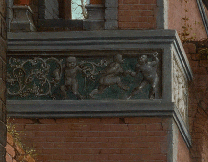
View enlargement in Image Viewer
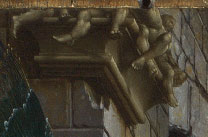
View enlargement in Image Viewer
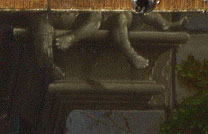
View enlargement in Image Viewer
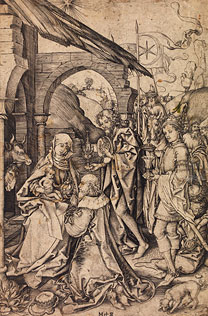
The Virgin and Child have blue eyes and gilded haloes (fig.29). The eldest king, Caspar, who has greenish-grey eyes and a wart on his left cheek (fig.21), has offered his gift of gold coins in a golden goblet. The Child takes one of the coins in his left hand. The cover of the goblet, inscribed with the king’s name: [L]E ROII IASPAR, lies at the feet of the Virgin; the goblet itself is ornamented with columns, lions and roundels of men’s heads. In front of Caspar are his hat (the fleurs-de-lis around the crown look black but are in fact azurite) and his sceptre, which incorporates two naked babies holding looped ropes and a figure of Moses holding the Tables of the Law (fig.30). The second king, Melchior, who has brown eyes, stands behind Caspar and wears a doublet of green patterned in silver beneath a coat of cloth of gold patterned in azurite and lined with ermine. He carries his frankincense in an elaborate golden vessel ornamented with figures of (?) prophets (fig.22). Behind him are four attendants, the second of whom carries a sword and mantle and the fourth of whom, on the extreme right, is wearing sandals in the Roman fashion. The third king, Balthasar, approaches from our left. His elaborate hat, which incorporates a crown, is inscribed with his name, BALTAZAR, and with the artist’s signature (figs.3, 2). Balthasar’s mantle is lined with striped and spotted lynx fur and his boots are made of leather so thin that his toes and toenails can de distinguished (fig.31). Around his neck he wears a fringed stole inscribed with the opening words of the ‘Salve regina misericordiae’, a prayer or hymn to the Virgin (fig.4). His gift of myrrh is contained in an elaborate golden vessel ornamented at the top with three figures of naked babies. Behind him are three attendants (fig.22): the foremost, dressed in rich textiles paned together, seems to have red pimples on his chin; the second, who is black, wears a silver collar inscribed with the painter’s name (fig.1). Through the window on our left are seen two men in exotic clothes, evidently attendants of the kings. On the far right, the horseman wearing a turban and holding a heavy ornamented hammer is another of their retinue; other mounted attendants appear in the distance (fig.32).
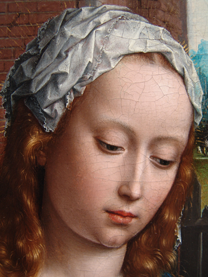
View enlargement in Image Viewer
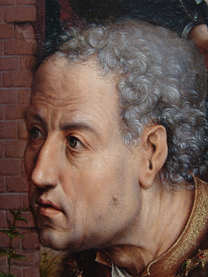
View enlargement in Image Viewer
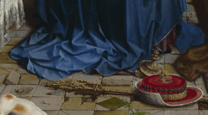
View enlargement in Image Viewer
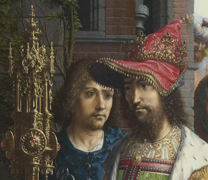
View enlargement in Image Viewer
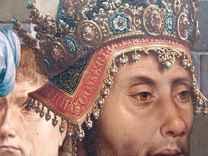
View enlargement in Image Viewer
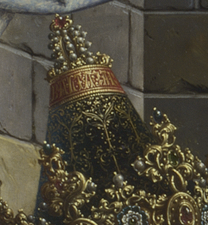
View enlargement in Image Viewer
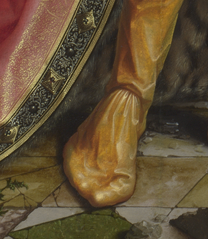
View enlargement in Image Viewer
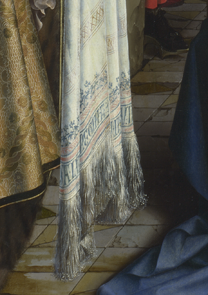
View enlargement in Image Viewer
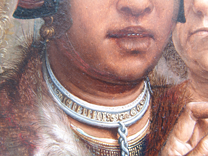
View enlargement in Image Viewer
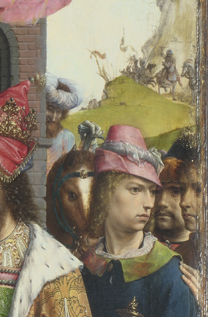
View enlargement in Image Viewer
Between Balthasar and the Virgin, Saint Joseph leans on his staff. Behind him, the head of the ox appears through a doorway in which stands an angel, his right hand on his breast. His robe is green, his wing light yellow and pinkish-red (fig.33). The ass, between the Virgin and Caspar, is eating weeds (fig.34). Directly behind Caspar are two shepherds. The one on our left carries a musical instrument similar to a recorder; the other holds a straw hat and an ‘houlette’, a trowel-like implement used in herding sheep. Hanging from his neck on a twisted cord is a small horn (fig.35). The four men between the shepherd with the ‘houlette’ and the Virgin are evidently also shepherds, and behind them other shepherds are receiving the news of Christ’s birth in fields outside a town where there are many large buildings in exotic styles (fig.34).
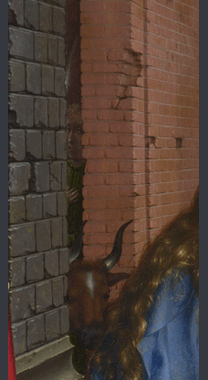
View enlargement in Image Viewer
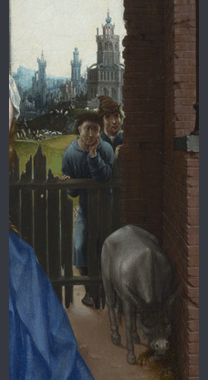
View enlargement in Image Viewer
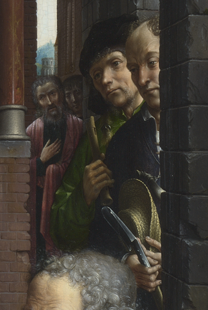
View enlargement in Image Viewer
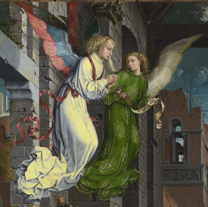
View enlargement in Image Viewer
Above, nine angels are hovering or flying. The two on the left (fig.36), but not the others, wear jewelled headbands and the second holds a scroll inscribed: Gloria in excelcis [sic] deo (Luke 2:14). The foremost angels on the left and right wear robes made of shot fabrics: yellow shot with blue and pink shot with yellow.51 At the top edge of the picture blazes the star that guided the kings. Below the star hovers the dove, representing the Holy Ghost.
